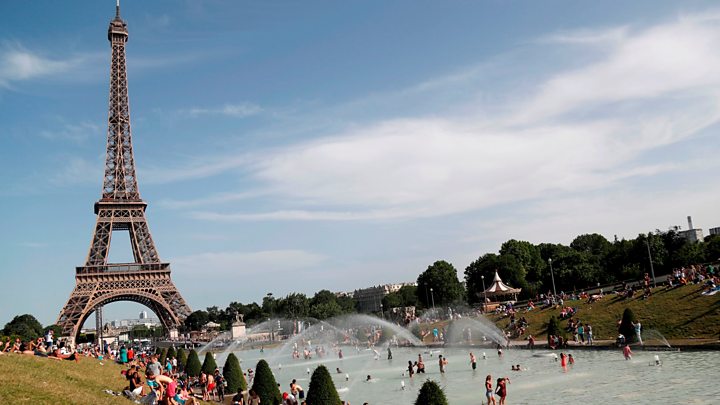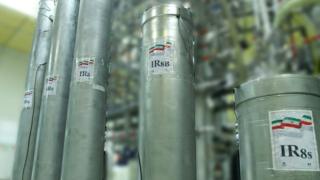 Image copyright
Image copyright
NASA
Last week’s record breaking heatwave across much of Europe was made “at least five times” more likely to happen by climate change, say scientists.
Their rapid attribution study says that rising temperatures “super-charged” the event, making it more likely to happen than through natural variability alone.
Heatwaves in June are now about 4C hotter than they used to be, the researchers said.
Globally, the average temperature for June was the highest on record.
Heatwaves naturally occur in summertime but last week’s event in many European countries was unprecedented because it happened so early, and the recorded temperatures were so high.
Records were broken at locations in France, Switzerland, Austria, Germany and Spain.
The new French record, established at Gallargues-le-Montueux last Friday, was more than 1.5C above the previous high mark.
Much of the concern about the heat focused on France, with red alerts in several areas, many schools were closed, exams were postponed and health minister Agnès Buzyn warned that “everyone is at risk”.
The immediate cause of the heatwave was the weather, with hot air drawn in from northern Africa, caused by high pressure over central Europe and a storm stalling over the Atlantic.

Media playback is unsupported on your device
By lucky coincidence, the authors of this new study happened to be in Toulouse, France, at a conference on climate change and extreme events.
The researchers, members of the World Weather Attribution Group decided to use the opportunity to analyse the link between human-induced climate change and the heatwave.
They defined the heatwave as the highest three-day averaged daily mean temperature in June, arguing that this is a better indicator of health impacts than maximums or minimums.
The researchers compared the observations of temperatures recorded during the month of June with climate models that can show how the world would be without the human influence on the climate.
They found that, over France, the probability of having a heatwave had increased by at least a factor of five. However, the researchers say that this influence could be much higher still, by a factor of 100 or more.
“We are very confident that this lower boundary of factor five is valid – but we are not confident we can say much more than that,” said Dr Geert Jan van Oldenborgh, senior researcher at the Royal Netherlands Meteorological Institute.
“The reason we are fairly careful is because we found fairly large discrepancies between the modelled properties of heatwaves and the observed properties of heatwaves. They all show stronger heatwaves but the trend in the observations is much larger than in the trends in the model.”
Image copyright
Getty Images
The heatwave sparked wildfires in Spain
The scientists say that the observations indicate a heatwave trend of around 4C in June, where the models show a much lower trend.
According to the Copernicus Climate Change Service, June generally was more than 2 degrees above the long term average. Globally the temperature was also the highest for June on record, being about 0.1C higher than 2016.
Heatwaves in the 1970s and 1980s in Europe were limited somewhat because of what’s termed aerosol cooling. This is essentially the impact of air pollution which for a number of years exerted a cooling influence. However, as the air has become clearer, heatwaves have come back with a vengeance.
According to those involved with this study, this trend in heatwaves is likely to get worse.
“We experienced a heatwave whose intensity could become the norm in the middle of the century,” said Dr Robert Vautard, Senior Scientist, CNRS, France.
“The new record of 45.9C set in France last Friday is one more step to confirmation that, without urgent climate mitigation actions, temperatures in France could potentially rise to about 50°C or more in France by the end of the century.”
The researchers believe that if global warming continues to the 2C level envisioned in the Paris climate agreement, heatwaves like the one experienced last week will become the norm in June.












